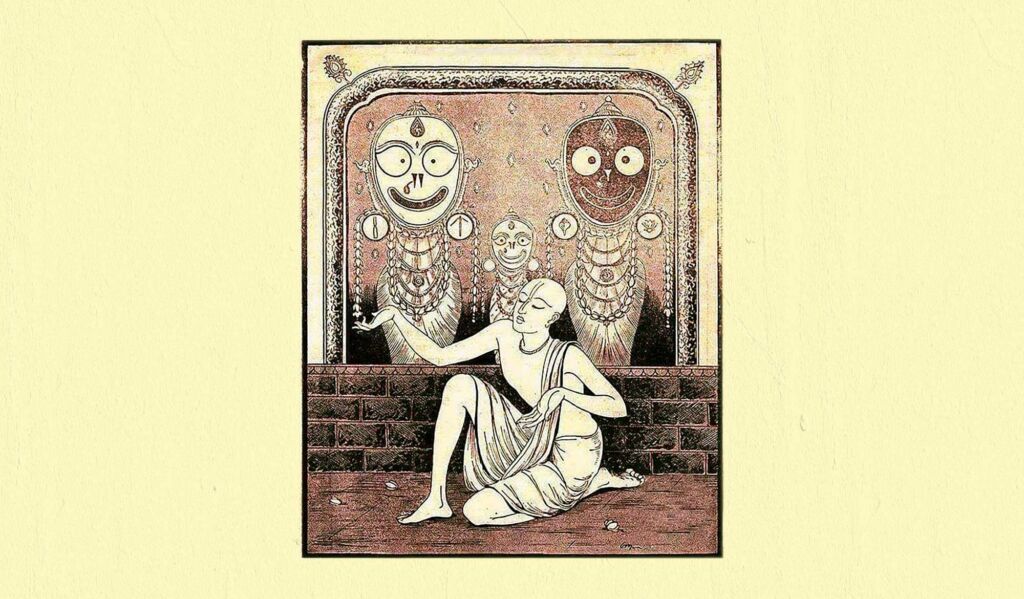Śrī Śīkṣāṣṭakam Verse Six
With the Sammodana Bhāṣyam by Śrīla Bhaktivinoda Ṭhākura
(translated by Swami B.V. Giri)
VERSE 6
nayanaṁ galad-aśru-dhārayā
vadanaṁ gadgada-ruddhayā girā
pulakair nicitaṁ vapuḥ kadā
tava nāma-grahaṇe bhaviṣyati
O Lord! When will my eyes be decorated with a flood of tears as I chant Your Holy Names? At the time of chanting, when will my voice falter as the Name comes from my mouth, and the hairs of my entire body will stand on end?
The previous five ślokas have discussed śraddhā, then sādhu–saṅga, then bhajana comprised of śravaṇa, kīrtana, smaraṇa, pāda-sevana, arcana, vandana, dāsya, sakhya and ātma–nivedana. Then after the awakening of one’s svarūpa, the eradication of anarthas which are forms of ignorance, then niṣṭhā, then ruci, the āsakti, then bhāva etc. These are the gradual symptoms where the supreme nature of the jīva’s svarūpa expands aided by the essential function of hlādinī. On the platform of bhāva, the pure nature of bhakti becomes unbreakable and perfect. Then bhakti assumes the form of rati (divine attraction) which is the bud of prema. Amongst those characteristics found at the stage of sādhana, such as hearing, chanting etc., kṛṣṇa-nāma-kīrtana becomes extremely strong at the stage of bhāva. This is concluded from this statement:
kṣāntir avyartha-kālatvaṁ viraktir māna-śūnyatā
āśā-bandhaḥ samutkaṇṭhā nāma-gāne sadā ruciḥ
āsaktis tad-guṇākhyāne prītis tad-vasati-sthale
ity-ādayo’nubhāvāḥ syur jāta-bhāvāṅkure jane
“When the sprout of bhāva appears within a person, the following anubhāvas (subordinate symptoms of ecstasy) develop – tolerance, a concern not to waste time, detachment, an absence of pride, hope, yearning, a constant taste for chanting the Holy Name, and an attachment in describing the Lord’s qualities, and love towards His abode.” (Bhakti-rasāmṛta-sindhu 1.3.25-26)
Furthermore, it is said:
śuddha-sattva-viśeṣātmā prema-sūryāṁśu-sāmya-bhāk
rucibhiś citta-masṛṇya-kṛd asau bhāva ucyate
“That which by nature is comprised of pure goodness, which is like a ray of the sun of prema, and which makes the heart soft due to various tastes is known as bhāva.” (Bhakti-rasāmṛta-sindhu 1.3.1)
From these characteristics, it is concluded that inherent nature of bhāva, or rati, is that it is the bud of prema and is a particle of prema.
premṇas tu prathamāvasthā bhāva ity abhidhīyate
sāttvikāḥ svalpa-mātrāḥ syur atrāśru-pulakādayaḥ
“The initial stage of prema is known as bhāva where symptoms of sāttvika-bhāva, such as hairs standing on end, weeping and trembling appear to a certain degree.”(Bhakti-rasāmṛta-sindhu 1.3.2)
dhyāyaṁ dhyāyaṁ bhagavataḥ pādāmbhuja-yugaṁ tadā
īṣad-vikriyamāṇātmā sārdra-dṛṣṭir abhūd asau
“Constantly meditating upon the lotus-feet of Bhagavān, Ambarīṣa developed partial transformations with his heart and his eyes were full of tears.” (Bhakti-rasāmṛta-sindhu 1.3.1)
According to the Purāṇas and Tantras, all the transformations of bhakti found in the anubhāvas and sāttvika–bhāvas that arise as symptoms of prema are seen to a certain extent at the stage of bhāva.
The anubhāvas are described thus:
nṛtyaṁ viluṭhitaṁ gītaṁ krośanaṁ tanu-moṭanam
huṅkāro jṛmbhaṇaṁ śvāsa-bhūmā lokānapekṣitā
lālā-sravo’ṭṭahāsaś ca ghūrṇā-hikkādayo’pi ca
“Dancing, rolling upon the ground, singing, weeping, stretching the body, shouting, yawning, sighing heavily, neglecting others, drooling, laughing loudly, staggering and hiccups.” (Bhakti-rasāmṛta-sindhu 2.2.2)
The sāttvika transformations are described thus:
te stambha-sveda-romāñcāḥ svara-bhedo ‘tha vepathuḥ
vaivarṇyam aśru-pralaya ity aṣṭau sāttvikāḥ smṛtāḥ
“Paralysis, perspiring, hairs standing on end, the faltering of the voice, shivering, a change of bodily hue, tears and fainting due to devastation – these should be understood to be the eight sāttvika–bhāvas.” (Bhakti-rasāmṛta-sindhu 2.3.16)
Amongst these, dancing, singing, weeping, hairs standing on end, and the faltering of the voice are specifically seen at the stage of bhāva. Therefore, Śrī Gauracandra, the crown-jewel of teachers, has spoken, describing this stage.
O Kṛṣṇa! O Nanda-nandana! When will torrents of tears flow from my eyes when I chant Your Names? When will there be transformations in my voice as it falters and chokes up? When will the hairs on my body stand on end? O Lord! May the symptoms of this stage quickly come to me as I chant Your Name.









